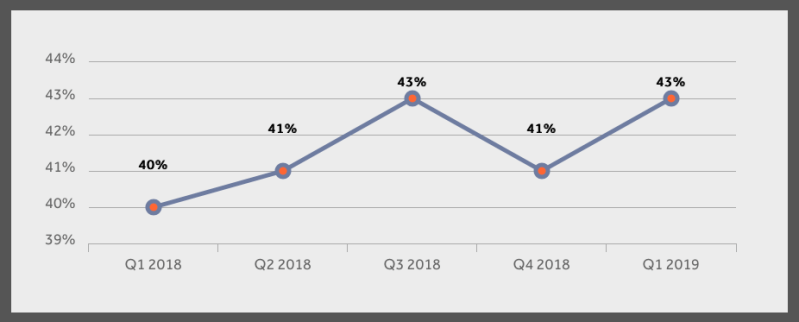testsetset
Intelligence and ephemeral social are two of the biggest drivers of evolving ad spend, according to a Q1 digital advertising benchmark report this week from Marin Software. Unsurprisingly, the intelligence piece comes from Google, and the social comes from Facebook.
Marin says that there’s been a major increase in search marketers using Google’s responsive search ads, which are still theoretically in beta despite having launched almost a year ago. 24% of search advertisers are already using this new format, which employs machine learning to mix multiple headlines and descriptions into almost 45,000 unique combinations per ad for the best impact.
RSAs have about a 5-15% increase in click-through rate over standard text ads.

Above: Mobile’s share of advertising is still growing.
In social, Instagram has been a huge driver for Facebook and now accounts for 19.5% of brand spend with the largest social network. That’s almost double what it was a year ago. Notably, ads in Instagram Stories — ephemeral photos and videos that delete soon after publishing — have contributed about a third of Instagram’s total ad revenue over the past year.
June 5th: The AI Audit in NYC
Join us next week in NYC to engage with top executive leaders, delving into strategies for auditing AI models to ensure fairness, optimal performance, and ethical compliance across diverse organizations. Secure your attendance for this exclusive invite-only event.
All that extra inventory in the Facebook ecosystem has contributed to pushing average costs down to $3.16 per thousand impressions. That’s significantly less than $3.67 in the same quarter last year, and it’s more striking given the high of $4.31 in Q3 2018.
It’s an open question, however, whether Story ads are effective.
“[The] jury is still out on this one,” Marin’s SVP of marketing Wes MacLaggan told me via email. “Facebook is trying to offer both brand- and performance-oriented formats, but we don’t have a good independent lift study yet. Because Facebook will include view-through conversions, advertisers need to be careful to ensure that conversions are incremental when thinking about performance of Stories ads.”
Oddly, Messenger had the highest cost per click of any Facebook ad inventory so far this year. That might be due to relatively thin usage, causing data to be heavily influenced by just a few advertisers, MacLaggan said.
Another other major trend is the inverse movement on two key indicators in the search advertising ecosystem: click volume and cost per click. Click volume continued to rise in the first quarter of 2019 — somewhat surprising given the fact that the retail-heavy holiday season just passed — but cost per click decreased, continuing a trend over the past four quarters.

Above: Trends in search advertising, according to Marin Software
In search, shopping ads captured 39% of budgets spent with Google, which is a sign that retail is increasingly driven by performance marketing. (That’s also an indicator showing why Amazon is beefing up its advertising engine.) The major retailers are driving this, because only 22% of advertisers are using shopping ads, but they’re driving outsized spend.
And, not shockingly, mobile is still king, with 43% of spend share across the $4 billion that Marin analyzed.

